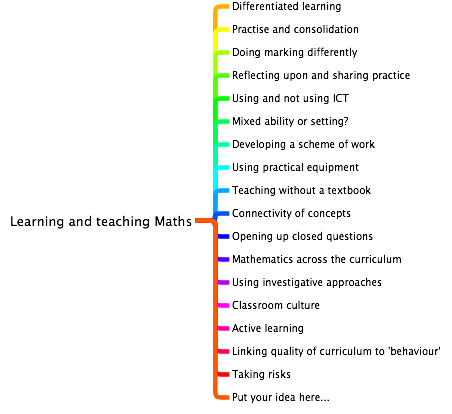February 23rd, 2005
- Cumulative frequency curve summary from the Teacher Training Agency!
- The TTA material covers the syllabus for the Numeracy test that newly qualified teachers must take
- The material is presented as Web pages that are also available in a plain form for printing out
- Areas of numeracy covered
- There are interactive practice tests available as well as written questions
- Could be handy for Access students, especially those interested in teaching
Posted in Maths | Comments Off
February 23rd, 2005
The Centre for Innovation in Mathematics Teaching has a range of simple Web pages that set up a problem in a context using GCSE level Maths.
Posted in Maths | Comments Off
February 21st, 2005

Sebastian Krauss provides MyMind 1.2 a small free outliner and mind mapping tool for the Mac OS X platform. Very simple and basic which actually makes it more useful than the all singing mind mappers around.
MyMind can export its map views as Web pages with a client side image map coded in. Site maps like the one above become possible… clickable mind maps for new modules sounds like it could be fun.
Posted in Web | Comments Off
February 20th, 2005
“The formula for writing Essays is rather loose. It was invented by Michel Montaign in the sixteenth century. It was a variation on the sermon. A sermon is traditionally appended to an opening biblical text which it refers, or at least alludes to, the holiday when the sermon was delivered. It is a fantasy or a reverie on a theme suggested by the opening text, ending with reference to the beginning and with a moral as its coda. An essay is similar, though without the opening topical sacred text, or with an opening that refers to a secular topical matter; its quotations are not only from Scriptures but also from the classics. Like the sermon, the essay is a fantasy or a reverie with a moral, but one much more general than that of a sermon, which was usually meant to arouse in the audience their sense of guilt.”
- Professor Joseph Agassi , Dissertation without tears
Posted in Notes | Comments Off
February 20th, 2005

The diagram above is re-drawn from Mike Ollerton’s book Getting the buggers to add up published by Continuum. Most of the issues he raises for engaging children and teenagers are alive and well for adults...
- Take away aspects of ‘behaviour’ – less challenging anyway
- Add in a big set of built in hangups and partial constructs about what maths is
Posted in Maths | Comments Off
February 20th, 2005
Gerry McGovern suggests (see Secrets of great Web headings )
- Headings and titles less than 8 words, nearer 4
- Summaries less than 30 words
- Online research indicates most summaries coming in at 17 words with a low of 10 and a high of 25
Idea for lesson activity: take typical Intranet news item text and write a page title and summary on 5 by 3 card. Swap with another member of the group and then ask them what they think might be on the rest of the page. Compare to the full page content and evaluate what use the heading and summary was in acting as an ‘advance organiser’ for the page.
I found McGovern’s page via the usable help blog.
Posted in Web | Comments Off
February 19th, 2005
“The Netscape palette for foreground colors usually (but NOT always) consists of all the combinations of 00, 33, 66, 99, CC, FF for each of the red, green, and blue elements of the color descriptor. This results in 216 (6×6x6) distinct colors.” – Victor Engel
A colour taken from the 216 cube is guranteed to reproduce as solid colour without dithering on most Web browser and screen combinations. Page colours and menu items are usually taken from this colour space.
Posted in Web | Comments Off

